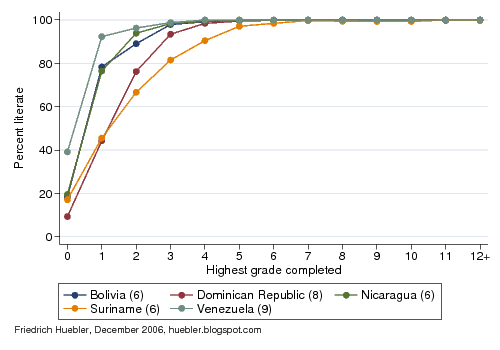A previous article on this site, "Years of schooling and literacy: Can everyone with primary education read and write?", analyzed data on years of schooling and literacy from 26 household surveys in Sub-Saharan Africa. The results showed that most persons who graduated from primary school or attended higher levels of education can indeed be considered literate and that the share of the adult population with at least a complete primary education is therefore a suitable proxy for the adult literacy rate.
The present article extends the analysis from Sub-Saharan Africa to 19 additional countries from Latin America, North Africa, Asia, and Eastern Europe. The data, collected between 1998 and 2004, is from 15 Multiple Indicator Cluster Surveys (MICS) funded by UNICEF, and 4 Demographic and Health Surveys (DHS) funded by the United States Agency for International Development (USAID). The surveys and data collection methods are described in detail in the previous article with literacy data from Sub-Saharan Africa.
For the analysis that follows, household members in each survey dataset were divided into 13 groups according to the highest grade of formal education completed: no formal education, grade 1 completed, grade 2 completed, ..., grade 11 completed, and grade 12 or higher completed. Within each group, the share of literate persons was calculated. The results are plotted in the graphs below.
For the presentation of the results, countries are grouped according to the geographic regions used by UNICEF. The first graph shows data from 5 countries in Latin America and the Caribbean. For each country, a line indicates how the percentage of literate persons varies with the completed years of formal education. In Suriname, for example (the orange line in the graph), 17 percent of all persons without formal education are literate, compared to 46 percent of those who completed the first grade, 67 percent of those who completed the second grade, and so on. The number in parentheses behind the name of each country indicates the official length of primary education in years. For example, primary school has six grades in Bolivia and eight grades in the Dominican Republic.
The available data for Latin American and the Caribbean shows that the education systems in this region perform very well in terms of literacy. Literacy rates increase steadily with increasing years of education and by the time children complete primary school, close to 100 percent can read and write.
Years of education and literacy in Latin America and the Caribbean

Data source: 3 DHS and 2 MICS surveys, 1999-2004. - Number after country name indicates official duration of primary education.
The second graphs shows data from 6 countries in Central and Eastern Europe and the Commonwealth of Independent States. In contrast to Latin America and the Caribbean, completion of primary school does not guarantee literacy. In Tajikistan, only 87 percent of those with complete primary education can be considered literate. In Azerbaijan and Moldova, literacy rates are 93 to 94 percent after graduation from the last grade of primary school. The low literacy rate among persons with four years of education in Uzbekistan is an outlier caused by a skewed age distribution. This group includes a high share of persons above 60 years of age who left school after completing primary school and who have relatively low literacy levels compared to other groups. In all countries literacy levels are near 100 percent once a person has 8 or more years of education.
Years of education and literacy in Central and Eastern Europe and the Commonwealth of Independent States

Data source: 6 MICS surveys, 2000. - Number after country name indicates official duration of primary education.
The last graph combines 8 countries from 3 UNICEF regions: the Middle East and North Africa, South Asia, and East Asia. The results are similar to those for Latin America and the Caribbean. Virtually all children who graduate from primary school can read and write. Even in Iraq, the country with the slowest increase in literacy rates according to the highest grade completed, 99 percent of primary school graduates could read and write (the data for Iraq was collected in 2000, before the current war).
Years of education and literacy in East Asia, South Asia, and the Middle East and North Africa

Data source: 1 DHS and 7 MICS surveys, 1998-2003. - Number after country name indicates official duration of primary education.
To summarize, in most countries completion of primary school provides students with the necessary reading and writing skills. There are exceptions, especially in some former states of the Soviet Union (see above) and in parts of West and Central Africa (see the previous article), where additional years of education are needed to guarantee literacy. In spite of these limitations, the share of the population with at least a complete primary education can be considered a good indicator for the adult literacy rate.
References
- UNESCO. 2006. Education for All Global Monitoring Report 2007: Strong foundations - Early childhood care and education. Paris: UNESCO.
- Years of schooling and literacy: Can everyone with primary education read and write?
- EFA Development Index: Assessing progress toward Education for All
- Education data from household surveys
- Millennium Development Goal regions and UNICEF regions
- Multiple Indicator Cluster Surveys
- Demographic and Health Surveys
- Education for All Global Monitoring Report 2007
Permanent URL: http://huebler.blogspot.com/2006/12/years-of-schooling-and-literacy-part-2.html
No comments:
Post a Comment